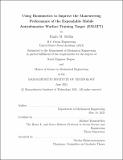| dc.contributor.advisor | Triantafyllou, Michael | |
| dc.contributor.author | Mellin, Emily M. | |
| dc.date.accessioned | 2022-01-14T15:06:33Z | |
| dc.date.available | 2022-01-14T15:06:33Z | |
| dc.date.issued | 2021-06 | |
| dc.date.submitted | 2021-06-30T15:28:46.256Z | |
| dc.identifier.uri | https://hdl.handle.net/1721.1/139360 | |
| dc.description.abstract | Using Biomimetics to improve the maneuverability of torpedo shaped Unmanned Underwater Vehicles (UUVs) is a continued topic of study that is rapidly evolving to increase the agility of these vehicles. MIT Sea Grant continues to study the hydrodynamic effects of UUVs and implement biomimetic methods to improve their maneuvering characteristics and efficiency. Triantafyllou et al[1] implemented dorsal fins on the REMUS UUV to quantify this increase in turning rate and maneuverability. This thesis uses the results from the work on the REMUS and applies it to Lockheed Martin’s EMATT UUV, now termed Morpheus, to improve the maneuverability of the vehicle. The mission of Morpheus includes driving on a steady course for periods of time as well as turning quickly and sharply on short notice, requiring both stability and maneuverability. The biomimetic improvement applied to Morpheus allows the dorsal fins to morph in and out of the body as well as deflect in the opposite direction of the rudder.
This thesis derives the equations of motion and hydrodynamic coefficients of the Morpheus vehicle and uses these to investigate the results of adding morphing dorsal fins. Dynamic tow tank experiments were conducted to validate the estimated hydrodynamic coefficients of a 75% Morpheus model as well as verify that the addition of dorsal fins increases the turning rate of the vehicle. This thesis investigates the appropriate size of these dorsal fins as well as the optimal location along the body of the vehicle using both field tests and simulations. The results showed the overall increase in the turning rate with the addition of a new tail design as well as morphing dorsal fins that are able to deflect in the opposite direction of the rudder compared to the original EMATT vehicle. | |
| dc.publisher | Massachusetts Institute of Technology | |
| dc.rights | In Copyright - Educational Use Permitted | |
| dc.rights | Copyright MIT | |
| dc.rights.uri | http://rightsstatements.org/page/InC-EDU/1.0/ | |
| dc.title | Using Biomimetics to Improve the Maneuvering Performance of the Expendable Mobile Antisubmarine Warfare Training Target (EMATT) | |
| dc.type | Thesis | |
| dc.description.degree | S.M. | |
| dc.description.degree | Nav.E. | |
| dc.contributor.department | Massachusetts Institute of Technology. Department of Mechanical Engineering | |
| mit.thesis.degree | Master | |
| mit.thesis.degree | Engineer | |
| thesis.degree.name | Master of Science in Mechanical Engineering | |
| thesis.degree.name | Naval Engineer | |
